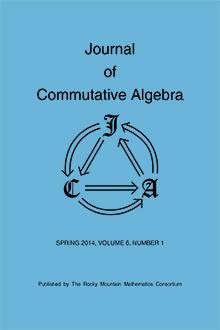Abstract
For a commutative ring $R$, one can form a graph $\Gamma (R)^*$ whose vertices are the zero divisors of $R$ (including $0$) and whose edges are the pairs $\{a,b\}$ where $ab=0$ with $a\ne b$. For this graph, a clique is a nonempty subset $X$ such that $ab=0$ for all $a\ne b$ in $X$. If $R$ is a finite ring, there is always a maximum clique of $\Gamma (R)^*$--a clique $X$ such that $|X|\ge |Y|$ for all cliques $Y$. We say that a finite ring $R$ has the clique ideal property if each maximum clique of $\Gamma (R)^*$ is an ideal of $R$. If $R=S\oplus T$ where both $S$ and $T$ are finite rings with the clique ideal property and neither $S$ nor $T$ is a field, then $R$ has the clique ideal property. The converse does not hold. For each positive integer $n>1$, the ring $R=\mathbb Z_n[\scriptstyle{mathrm{X}} ]/(\scriptstyle{mathrm{X}} ^2)$ is a finite ring with the clique ideal property. In contrast, $\mathbb {Z}_n$ has the clique ideal property if and only if $n$ is either a prime or a perfect square.
Citation
Thomas G. Lucas. "The clique ideal property." J. Commut. Algebra 10 (4) 499 - 544, 2018. https://doi.org/10.1216/JCA-2018-10-4-499
Information





